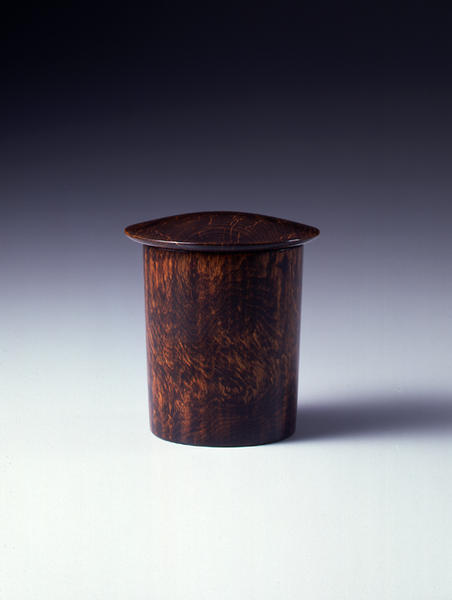溜塗蔦金輪寺茶器(黒田辰秋)
解説(春の玉手箱)
黒田辰秋は京都出身の木工・漆芸作家。柳宗悦等の民芸運動に初期から参画し、皇居新宮殿の拭漆樟大飾棚、扉飾および椅子、卓の製作を始め、重厚で素朴な作品を制作した。昭和四五年木工芸の重要無形文化財保持者(人間国宝)となる。
この「金輪寺」は自然の蔦をくりぬいた薄茶器である。金輪寺の呼称は、伝承によれば、後醍醐天皇が南北朝時代に吉野隠棲中、一山の僧に茶を供するために深山の蔦を用いて器を造らせたことに由来する。室町時代と思われる古作をはじめ、茶道で使われたため時折散見されるが、古いものほど蓋が堂の軒のように出ており、中に写経の入ったものがあることから、実際は小型の経筒として生まれたものを、後に茶器に転用したものであろう。極めてシンプルな姿をしているにもかかわらず、まるで美しい塔を見るような大きさを備えている。黒田はこの金輪寺の茶入を数多く製作したが、“木工では最高のもの”と賞賛し、歴史の中で突き詰められて出来たこのシンプルな姿に、決して手を加えることはしなかったという。
Catalogue Entry
Kuroda Tatsuaki was a Kyoto‐born wood and lacquer artist. He participated in Yanagi Soetsu's Mingei movement from its early stages, and created an array of simple, yet dignified works such as the chairs, tables, door decoration and decorative shelves for the new Imperial Palace buildings. He was named a "Living National Treasure" for wood arts in 1970.
This Kinrinji tea container for thin tea is made from natural ivy. According to tradition, when Emperor Godaigo retired to Yoshino during the Nambokucho period, he made a tea container from mountain ivy to take to tea with a monk in the mountains. The oldest example of this style can be found to date from the Muromachi period and thanks to their use in the tea ceremony, examples can be found from various intervening periods. The older versions of this theme have lids which resemble temple roofs and some contain sutra copies. Indeed, some of these small jars may have been originally created to hold sutras, and were then transformed into tea containers. Regardless of this container's extremely simple shape, it has the resonant presence of a large pagoda. Kuroda created many of these Kinrinji tea containers and they were praised as "the pinnacle of wood art." But in fact, this simple natural shape used through the centuries takes almost no special handling to create its beauty.
